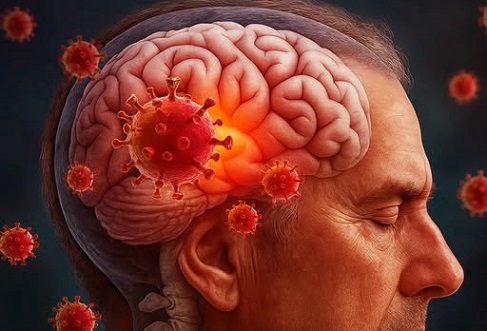Nikhil Prasad Fact checked by:Thailand Medical News Team Nov 23, 2025 39 minutes ago
Medical News: Growing Evidence That COVID Leaves Long Lasting Marks on the Brain
A new systematic review has revealed that COVID-19 may trigger subtle but persistent shrinkage in key brain regions months or even years after infection. Researchers from Tanta University Egypt; Mayo Clinic Arizona USA; Mansoura University Egypt; the National Institute on Drug Abuse at the US NIH; Barrow Neurological Institute USA; Arizona State University USA; and Mayo Clinic Rochester USA reviewed 41 structural MRI studies involving nearly 3000 post-COVID patients and 1700 healthy controls. Their findings add to mounting global concern that even mild infections could leave behind hidden neurological footprints. This
Medical News report highlights the alarming and most important discoveries found in this new study review of the post-effects of COVID-19 on the brain.
 A major review finds lasting shrinkage in key brain regions months after COVID infection
What the Researchers Investigated
A major review finds lasting shrinkage in key brain regions months after COVID infection
What the Researchers Investigated
The international team analyzed studies that scanned patients at least two weeks after infection using high-resolution MRI. They assessed total brain volume plus specific regions such as the hippocampus, amygdala, thalamus, basal ganglia, nucleus accumbens, and cerebellum. The studies came from China, Italy, Germany, the UK, Spain, Turkey, Russia, the USA, Australia, Brazil, Hungary, India, Argentina, and Austria. Although methods varied, a consistent pattern emerged.
Key Findings Showing Brain Volume Loss in Several Regions
Many studies reported significant volume reductions in the hippocampus, a region essential for learning and memory. Some research showed up to a 20 percent reduction compared to healthy individuals, especially among older patients or those who had severe COVID-19. The amygdala, which regulates emotion and stress responses, was also smaller in many post-COVID patients.
Shrinkage was likewise seen in the thalamus—the brain’s central relay station—and parts of the basal ganglia, which control movement and motivation.
These losses were observed months to years after infection, suggesting long-term neurological effects. Not all studies agreed, and some showed no change or even temporary increases possibly linked to swelling. However, the overall trend pointed toward lasting structural damage associated with inflammation, low oxygen levels during illness, or viral effects on brain tissue.
Why These Changes Matter
Such structural alterations could help explain the ongoing symptoms many individuals face, including fatigue, brain fog, memory issues, anxiety, disrupted sleep, and reduced smell. The review emphasizes that imaging biomarkers for post-COVID neurological decline are still lacking. Researchers stressed the need for standardized MRI protocols and long-term follow-up to better understand how these volumetric changes progress.
Conclusion
The review provides one of the strongest compilations to date showing that COVID-19 may subtl
y but meaningfully reshape the brain. While not every patient is affected and findings vary, the recurring pattern of hippocampal, amygdala, thalamic, and basal ganglia volume loss raises important public health concerns.
Continued research is essential to identify who is at risk, how these changes evolve over time, and whether early interventions can prevent long-term neurological harm.
The study findings were published in the peer reviewed journal: Brain Sciences
https://www.mdpi.com/2076-3425/15/12/1255
For the latest COVID-19 news, keep on logging to Thailand
Medical News.
Read Also:
https://www.thailandmedical.news/articles/coronavirus
